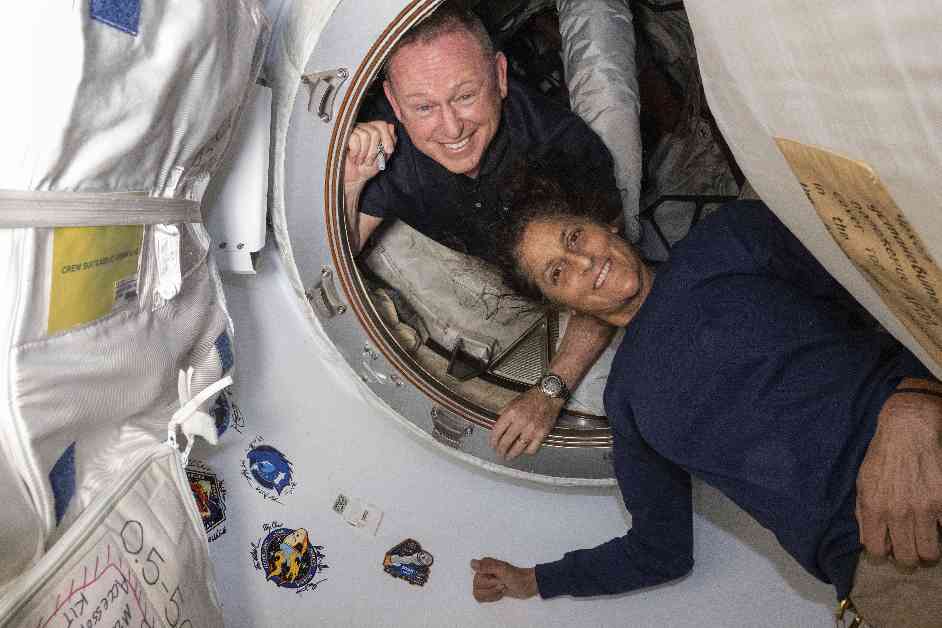Nasa is facing a difficult decision regarding the fate of two astronauts, Butch Wilmore and Suni Williams, who have been stranded at the International Space Station for over two months. The astronauts were originally scheduled to return to Earth in mid-June after completing their mission aboard Boeing’s Starliner spacecraft. However, technical issues with the craft have left them in limbo, unable to safely return home.
The problems with the Starliner spacecraft, including thruster failures and helium leaks, have raised serious concerns about its ability to make a safe return journey to Earth. As a result, Nasa officials are currently analyzing more data before making a decision on what to do with the stranded astronauts. One option being considered is to keep Wilmore and Williams at the space station until early next year, at which point they would catch a ride on SpaceX’s next flight.
This situation has put Nasa in a challenging position, as switching the astronauts to SpaceX’s Dragon capsule would require bumping two of the four astronauts currently assigned to the next ferry flight, scheduled for late September. Additionally, the space station only has two parking places for US capsules, so Boeing’s Starliner would need to depart before SpaceX’s Dragon can arrive and take its place.
The delays and uncertainties surrounding the Starliner mission have also impacted the current crew aboard the space station, who were originally scheduled to return to Earth this month but will now have to stay until the end of September. This extension adds an extra month to their mission, keeping them in space longer than anticipated.
Boeing was initially hired alongside SpaceX a decade ago to transport Nasa’s astronauts to and from the space station. While SpaceX successfully completed its first astronaut flight in 2020, Boeing has faced numerous challenges with its Starliner spacecraft. The company received a larger contract from Nasa compared to SpaceX, but has spent significantly more money on developing the spacecraft.
The dilemma of what to do with the stranded astronauts highlights the complexities and uncertainties of space travel, where even the best-laid plans can be derailed by technical issues and unforeseen challenges. Nasa’s careful analysis of the situation and consideration of all possible options demonstrate the agency’s commitment to ensuring the safety and well-being of its astronauts.
Challenges of Space Travel
Space travel is a risky and complex endeavor, with countless variables that can impact the success of a mission. The challenges faced by Nasa and its astronauts aboard the International Space Station serve as a reminder of the inherent uncertainties of exploring the cosmos.
The technical issues experienced by Boeing’s Starliner spacecraft, such as thruster failures and helium leaks, highlight the importance of rigorous testing and preparation before embarking on a mission. Even the most advanced technology can encounter unforeseen problems in the harsh environment of space, requiring careful analysis and decision-making by mission control.
The stranded astronauts, Butch Wilmore and Suni Williams, are facing an extended stay aboard the space station due to the uncertainties surrounding their return journey. While Nasa is working diligently to resolve the situation and ensure the safety of the astronauts, the realities of space travel mean that unexpected delays and complications can arise at any moment.
Implications for Future Missions
The challenges faced by Nasa and Boeing in the Starliner mission have significant implications for future space travel and exploration. As space agencies around the world plan ambitious missions to the Moon, Mars, and beyond, the lessons learned from this experience will be invaluable in improving the safety and reliability of spacecraft.
The need for redundancy and backup systems in spacecraft design is underscored by the technical issues encountered by the Starliner spacecraft. Ensuring that astronauts have multiple options for safe return to Earth in the event of a malfunction is essential for the success of future missions to the space station and beyond.
The collaboration between Nasa and commercial partners like Boeing and SpaceX has revolutionized space travel, opening up new possibilities for human exploration of the cosmos. While setbacks and challenges are inevitable in such a high-risk environment, the dedication and expertise of the teams involved in these missions demonstrate the resilience and determination of the space exploration community.
Conclusion
In conclusion, the dilemma of bringing stranded astronauts back to Earth is a complex and challenging problem that requires careful consideration and analysis by Nasa and its partners. The technical issues experienced by the Starliner spacecraft highlight the inherent risks of space travel and the importance of thorough testing and preparation before embarking on a mission.
As Nasa continues to evaluate the situation and weigh their options for the stranded astronauts, the lessons learned from this experience will inform future missions and improve the safety and reliability of spacecraft. The dedication and expertise of the astronauts and mission control teams involved in these missions demonstrate the incredible resilience and capabilities of the human spirit in the face of adversity.













